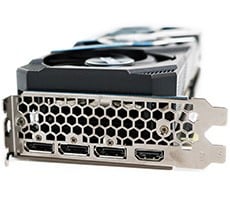AMD Radeon R9 Nano Review: Small But Mighty Fiji Unleashed
Performance Summary: The AMD Radeon R9 Nano performed well throughout our entire battery of tests, especially considering its form factor and power consumption characteristics. Save for a couple of instances, like in Thief and GTA V where the two cards were neck and neck, the Radeon R9 Nano typically performed a few percentage points behind the air-cooled Radeon R9 Fury, but significantly ahead of the Radeon R9 390 and NVIDIA's GeForce GTX 970. In terms of its performance per watt, the Nano was very strong; although the card wasn’t quite as fast as a Fury or Fury X overall, its power consumption was significantly lower—over 90 watts lower than a Fury X. The Nano’s GPU was easily overclocked and the card is relatively quiet as well, though the inductor noise we experienced with the card under load could be a hindrance for some users.
If we evaluated the Radeon R9 Nano strictly on the properties and merits of the hardware, we’d be heaping praise on AMD for producing such a unique product in the high-end graphics card space. There is nothing else currently available with such a small form factor that can offer the same level of performance or features than the Radeon R9 Nano. We must, however, also consider pricing and that’s when things get a little dicey. We think it is absolutely fair for AMD to command a premium for a specialized product like the R9 Nano that can be used in places a full-sized graphics card simply can’t address. Heck, the mini-GTX 970 we had in our charts for comparison is sold at a 15 – 20% premium too. But the asking price for the Nano is $650, which is right on par with the higher-performing Fury X. Solely in terms of performance per dollar, the R9 Nano’s value proposition isn’t great.
Whether or not you think the premium AMD is asking is reasonable will likely depend on your perspective. We believe some users will be OK with paying roughly 18% more than an air-cooled Fury for a card with such a tiny form factor, that offers 90% of the performance. But we also know there’s going to be others that scoff at the idea of paying more for a product because it’s smaller and more power friendly. And that’s if you can get your hands on them. Availability of Fiji-based cards has been slim. We suspect boutique system builders will gobble up R9 Nanos for small form factor builds and the channel won’t be flush with cards, but that’s to be expected with a specialized product like this. We’re told there will be availability in greater numbers than most are expecting, but we’ll have to see how that plays out. Cards can already be found, in-stock at a few on-line retailers.
Ultimately, we really dig the hardware AMD has produced here. The Radeon R9 Nano is a high-performing and efficient graphics card, packed into a miniscule form factor. In a market full of foot-longs, it was just plain cool to see a 6-incher hanging tough at the high-end. The Radeon R9 Nano is a hero-type product that demonstrates the kind of efficiency and diminutive form factor possible with Fiji and HBM. Those things come at a price, however. Whether or not you think the premium AMD is asking for the Nano is worth it, will depend on your particular needs or value scale. At the very least, we’re sure this release is going to spark some very interesting discussions—in fact, it already has...

|
|







